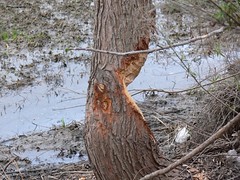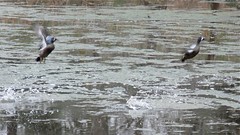 I spent a very cold and gloomy 2.5 hours birding Lake Creek Trail this morning. I was anxious to get out and bird since I had been down with a sore throat for the past few days. I just wish it had been a little warmer! The high humidity and light wind made the 30 degree temperature feel even colder. Still, the birds were relatively active and I found 48 species by the time I was done. I started in the marshy area by the Parmer Lane bridge where a few weeks ago I found evidence of beavers. This morning I was startled to find a severed beaver head on the ground in the same area. I have no idea if it was people or animals that killed this beaver, or where the rest of its body was. A little further down the trail I discovered that the largest willow tree left on the bank had been gnawed through about 2/3 of the way by a beaver. It's pictured here. I doubt this tree will survive. Both discoveries added to the gloominess this morning.
I spent a very cold and gloomy 2.5 hours birding Lake Creek Trail this morning. I was anxious to get out and bird since I had been down with a sore throat for the past few days. I just wish it had been a little warmer! The high humidity and light wind made the 30 degree temperature feel even colder. Still, the birds were relatively active and I found 48 species by the time I was done. I started in the marshy area by the Parmer Lane bridge where a few weeks ago I found evidence of beavers. This morning I was startled to find a severed beaver head on the ground in the same area. I have no idea if it was people or animals that killed this beaver, or where the rest of its body was. A little further down the trail I discovered that the largest willow tree left on the bank had been gnawed through about 2/3 of the way by a beaver. It's pictured here. I doubt this tree will survive. Both discoveries added to the gloominess this morning.There was still plenty of life along the creek. In the marshy area I observed a Virginia Rail, Sora, Marsh Wren, Common Yellowthroat, Swamp Sparrow, and several Song Sparrows. Upstream by the last dam the woods were pretty birdy. There were Field Sparrows, White-throated Sparrows, Song Sparrows, Lincoln's Sparrows, Dark-eyed Juncos, a single Chipping Sparrow, and 3 species of woodpecker (Red-bellied, Ladder-backed, and Downy). There were 4 species of wild ducks nearby in the creek: Northern Shoveler, Gadwall, American Wigeon, and Blue-winged Teal. Here are 2 of the male Blue-winged Teal as they took off.

Soon after photographing these ducks I got tired of being so cold and walked back to my car. Back at home 3 hours later I think I'm just about thawed out.

5 comments:
We live very near the trail you speak of and heard what could only have been coyotes a couple of weeks ago. There where several and they were yelping - like a sort of celebratory sound. We wondered if they'd gotten a large kill of some sort. .
Then, my son and I were on the trail yesterday (the other end, near Broadmeade) and noticed an almost complete deer skeleton, picked very clean, though clearly not terribly old.
Today we were on the other end (near Parmer) and saw what I really think was coyote scat. It was made up almost entirely of fur, and placed right in the middle of the sidewalk (a marking behavior).
All of that to say that I'm certainly no expert, but it would not surprise me if that beaver fell to a coyote.
Thanks Stefani! Gracen Duffield lives along the creek near the Parmer Bridge and she has also heard coyotes recently -- just in the past few days.
In my very limited experience with beavers they aren't too fast on land and they escape by swimming. The water by the marsh where I found the beaver's head is very shallow, so I doubt a beaver would be able to use it to escape. A pack of coyotes could certainly take one there. But do you think a single coyote could?
I'm really not sure, Mikael. The few guides that I have do list coyotes among their natural predators. As do many online places: http://nature.ca/notebooks/englIsh/beaver.htm. I don't know though if that means that it would take only one coyote or several to do the job.
I do think that if our deer suffered the same fate, it was a pack, not an individual. It was a young deer I think, but still.
It's so amazing, what's to be found in our little patch of woods! Coyotes surprised me some, but beavers... I never would have imagined!
Yes, it's amazing how much wildlife uses the small patches of habitat we have in the neighborhood. I think it helps that right across Parmer Lane is undeveloped ranch land. I don't know how long it will stay undeveloped, but I suspect that's where many of the deer and coyotes spend their days.
Wow, maybe I should post about this evidence of coyote predation to promote keeping pet cats indoors!
Thanks for the updates on the beavers. I was down there last weekend and also saw the fresh tree damage. I also saw a couple very large burrow holes near the marsh that leads me to think the beavers are using burrows for dens vs. typical huts made of fallen tree limbs. The Texas beavers are known to burrow.
So with Coyotes in the area, shall we film our own nature reality series? Grab a motion sensor operated wireless tree cam... Ha!
See you Sunday. -Barry
Post a Comment